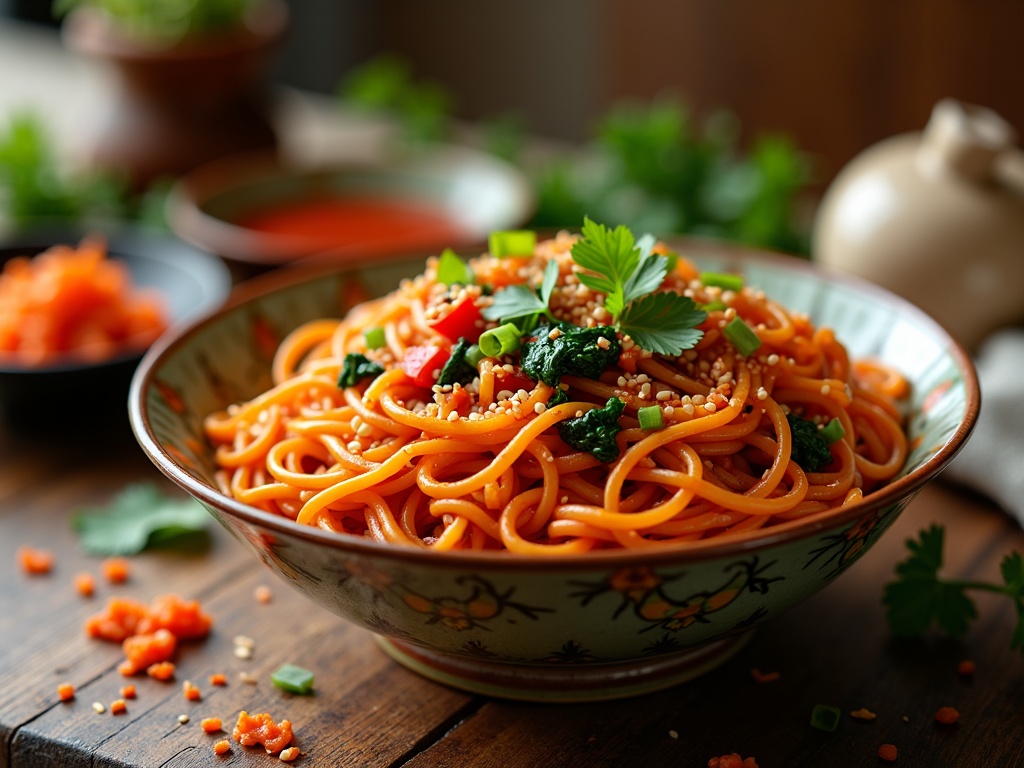Gochujang buttered noodles offer a perfect fusion of Korean flavors and pasta comfort by combining the spicy-sweet characteristics of fermented chili paste with the rich creaminess of butter. This 15-minute, one-pot wonder transforms ordinary noodles into an extraordinary meal that bridges culinary traditions while delivering a deeply satisfying balance of heat, sweetness, and umami.
Find In This Article
Key Takeaways
- The dish combines the familiar comfort of buttered noodles with the exciting depth of gochujang, a Korean fermented chili paste that offers both flavor complexity and potential probiotic benefits.
- With just five core ingredients (noodles, gochujang, butter, soy sauce, and sesame oil), this versatile recipe can be on the table in under 20 minutes.
- The recipe is highly customizable—add proteins like chicken or tofu, incorporate vegetables, or adjust the spice level to suit your taste preferences.
- Traditional Korean accompaniments like banchan (small side dishes) or cooling elements like cucumber salad perfectly balance the dish’s heat.
- Gochujang’s growing global popularity (a $237 million market with 6% annual growth) makes this dish a perfect entry point into Korean flavors for pasta lovers.
The Perfect Blend of Spicy and Creamy
The magic of gochujang buttered noodles lies in its perfect balance of familiar comfort and exciting flavor. This dish transforms ordinary pasta into something extraordinary with just a few ingredients. I’ve found that the deep, complex flavor of gochujang—a Korean fermented chili paste—creates an irresistible combination when paired with the rich smoothness of butter.
Flavor Profile and Health Benefits
Gochujang brings so much more than just heat to this dish. This brick-red paste delivers a unique blend of spicy, sweet, and deeply savory umami flavors that can’t be replicated by regular hot sauce. The fermentation process creates complex flavors while also offering potential health benefits. The probiotic content in fermented foods like gochujang can contribute to improved gut health and digestion—making this dish as beneficial as it is delicious.
What makes this recipe especially appealing is how it bridges culinary traditions. I’ve taken the comforting, familiar concept of buttered noodles that many grew up with and elevated it with the exciting heat of Korean cuisine. This cross-cultural approach creates a dish that feels both familiar and new at the same time.
The best part? You can have this flavorful meal on the table in just 15-20 minutes. For busy weeknights or when hunger strikes suddenly, few dishes deliver this much flavor in so little time. The entire preparation happens in a single pot, which means minimal cleanup afterward—another significant advantage on hectic days.
If you enjoy the spicy-creamy combination in these noodles, you might also love creamy pasta dishes with a kick of heat, or the garlicky goodness of spaghetti aglio olio which can be customized with chili flakes.
This dish is incredibly versatile and can be adapted to your taste preferences. Here are some ways to customize your gochujang buttered noodles:
- Add protein: Toss in some shredded chicken, sautéed shrimp, or tofu for a more substantial meal
- Include vegetables: Spinach, mushrooms, bell peppers, or carrots add nutrition and texture
- Adjust the heat: Start with less gochujang and add more to reach your desired spice level
- Garnish options: Fresh cilantro, sliced green onions, sesame seeds, or a squeeze of lime juice
The simplicity of this dish belies its complex flavor. The butter creates a silky sauce that coats each strand of pasta, while the gochujang delivers warmth that builds pleasantly with each bite. For pasta lovers looking to expand their horizons, this dish offers an accessible entry point into Korean flavors.
For those who enjoy pasta with bold flavors, you might also appreciate chorizo pasta or the briny intensity of spaghetti puttanesca. If you prefer creamy textures, chicken carbonara provides that same satisfying richness.
I find that gochujang buttered noodles satisfy cravings for both comfort food and exciting flavors. The dish proves that spectacular meals don’t require complicated techniques or long lists of ingredients—sometimes the most straightforward combinations create the most memorable results.
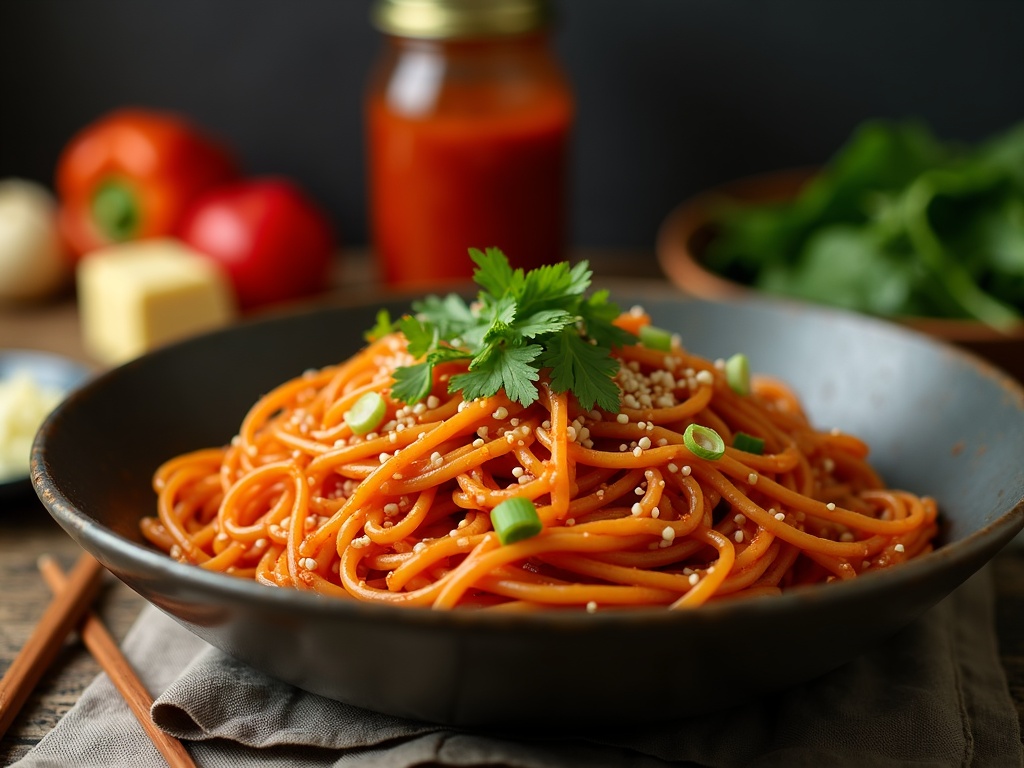
What You’ll Need
The beauty of gochujang buttered noodles lies in its simplicity and flexibility. I’ve made this dish countless times, tweaking the ingredients based on what’s in my pantry, and it never disappoints.
Core Ingredients and Variations
For the base recipe, you’ll need:
- 8 oz noodles (spaghetti, udon, or rice noodles)
- 2 tablespoons gochujang (Korean chili paste)
- 2 tablespoons butter
- 1 tablespoon soy sauce
- 1 tablespoon sesame oil
The noodle choice offers your first chance to customize this dish. I find that spaghetti noodles work perfectly if you’re looking for something with a bit of bite, while udon delivers a chewier texture. Rice noodles make this dish lighter and are perfect for hot summer days.
Gochujang is the star ingredient – this fermented Korean chili paste adds a complex sweet-spicy flavor that’s hard to substitute. The butter creates a silky sauce when combined with the paste, while soy sauce adds depth and sesame oil brings a nutty finish.
To elevate your dish, consider these optional toppings:
- Sliced green onions for freshness
- Toasted sesame seeds for crunch
- Protein options like tofu, chicken, or beef
- Vegetables such as spinach, mushrooms, or bok choy
This recipe is highly adaptable for dietary restrictions. For a vegan version, simply swap the butter for a plant-based alternative. If you’re gluten-free, use rice noodles instead of wheat-based options, and make sure your gochujang and soy sauce are certified gluten-free.
Looking to make it creamier? You might enjoy adding elements from a creamy pasta recipe by incorporating a splash of coconut milk or cashew cream.
For protein lovers, adding chicken transforms this into a heartier meal – similar to how chicken carbonara builds on simple pasta foundations.
The versatility of this dish means you can dress it up or down depending on the occasion. It works brilliantly as a quick weeknight dinner or as part of an elaborate spread for guests.
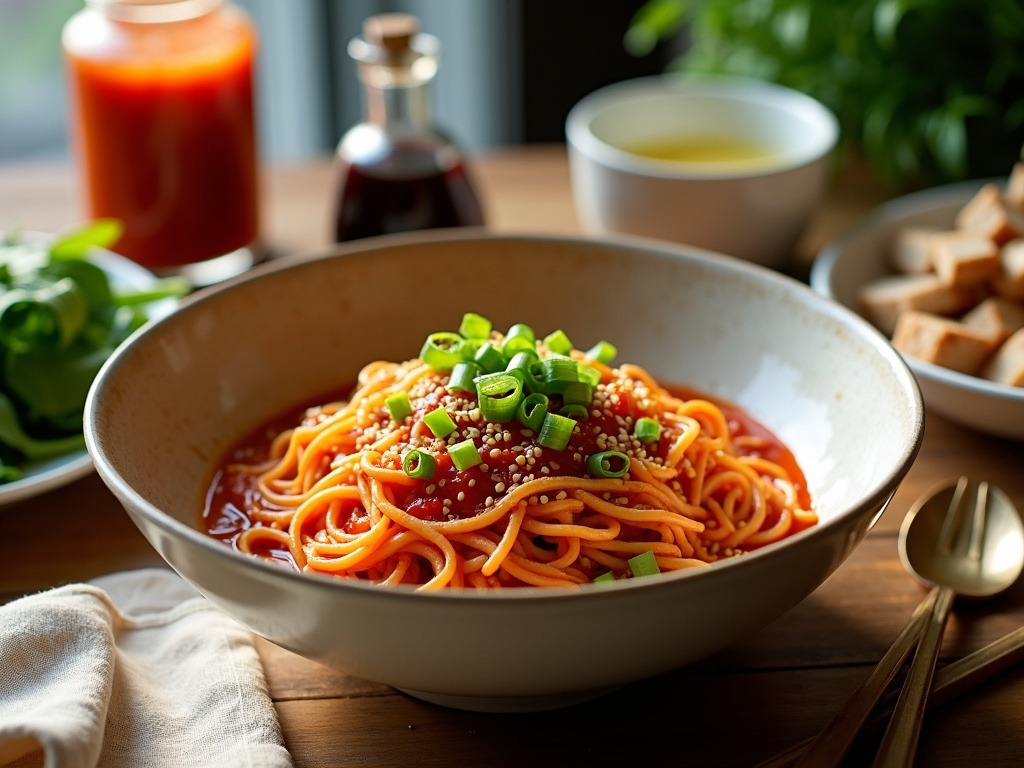
The Health Factor
I’ve always been a fan of knowing what’s in my food, especially when it comes to creating delicious pasta dishes at home. Gochujang buttered noodles blend incredible flavor with some surprising nutritional benefits you might not expect.
Nutritional Breakdown
Gochujang, the star Korean chili paste in this recipe, contains just 30 calories per tablespoon while packing a punch of antioxidants and vitamin A. These compounds help fight inflammation and support eye health. When I’m preparing simple pasta recipes like this, I’m always delighted by ingredients that offer both flavor and function.
Butter adds richness at 102 calories per tablespoon, but don’t let that scare you off. It provides healthy fats that help your body absorb fat-soluble vitamins and create that luxurious mouthfeel that makes creamy pasta dishes so satisfying.
The base noodles themselves contribute approximately 200 calories per cup when cooked. I like to think of pasta as the perfect vehicle for delivering both the spicy-sweet gochujang flavor and the nutrients from any added vegetables.
Speaking of vegetables, they’re what transform this dish from a simple comfort food to a more balanced meal. Adding colorful veggies to your pasta with unique ingredients significantly increases the fiber and nutrient content. Bell peppers add vitamin C, spinach brings iron and folate, while mushrooms offer B vitamins.
The dietary fiber from vegetables helps slow digestion, keeping you fuller longer and preventing the blood sugar spikes that can sometimes follow carb-heavy meals. I’ve found that adding at least a cup of mixed vegetables to my gochujang buttered noodles creates a more satisfying and nutritionally complete dish.
For protein, consider topping your noodles with a soft-boiled egg or adding some pan-seared tofu to make it a complete meal, similar to how chicken enhances carbonara recipes with additional protein.
Making It Special
When serving these vibrant Gochujang Buttered Noodles, I recommend portioning about 1-2 cups per person, depending on whether it’s a main dish or part of a larger spread. The spicy-sweet flavor profile creates endless opportunities to elevate this simple dish into something truly memorable.
Perfect Pairings
The tangy heat of gochujang butter sauce pairs wonderfully with cooling side dishes that balance the meal. I find these combinations work particularly well:
- Kimchi – The fermented vegetables provide a perfect contrast with their sour crunch
- Fresh leafy green salad with a light sesame dressing
- Quick-pickled vegetables for brightness
- Steamed or sautéed greens like bok choy or spinach
- Cucumber salad with rice vinegar and sesame oil
For a finishing touch that transforms these noodles into a complete meal, try adding a traditional fried egg on top. The runny yolk creates a rich sauce that mingles beautifully with the spicy butter coating. The contrast between the silky egg and the chewy noodles adds textural interest that makes each bite more satisfying.
Creating a Complete Korean Meal
These gochujang noodles can easily become the centerpiece of a more elaborate Korean dining experience. In traditional Korean meals, multiple small side dishes called banchan accompany the main course, creating a balanced and visually appealing spread.
To create an authentic Korean meal experience, I like to surround the noodles with an assortment of banchan options. Some classics include:
- Gamja jorim (braised potatoes)
- Kongnamul muchim (seasoned bean sprouts)
- Oi muchim (spicy cucumber salad)
- Sigeumchi namul (seasoned spinach)
- Gyeran mari (rolled omelette)
The beauty of banchan is how it allows diners to customize each bite by combining different flavors and textures. I appreciate how these small dishes create variety within the meal while complementing the creamy pasta base.
For a less traditional but equally delicious approach, these noodles can be served alongside other Korean-inspired favorites like chicken prepared in a savory sauce or beef bulgogi. The versatility of this dish makes it suitable for everything from weeknight dinners to special gatherings.
The gochujang butter sauce can even be adapted for other noodle varieties. While it works beautifully with standard wheat noodles, you might experiment with rice noodles, spaghetti in a simple oil-based preparation, or even avocado pasta for a fusion approach.
For those who enjoy the bright, punchy flavors of dishes like spaghetti puttanesca or chorizo pasta, these gochujang buttered noodles offer a similar bold flavor profile with a Korean twist.
By playing with different serving styles and accompaniments, this humble noodle dish becomes something worth sharing with friends and family. The complex flavors of the gochujang butter combined with thoughtfully chosen sides creates a meal that’s greater than the sum of its parts – bringing the vibrant, crave-worthy qualities of Korean cuisine to your table.
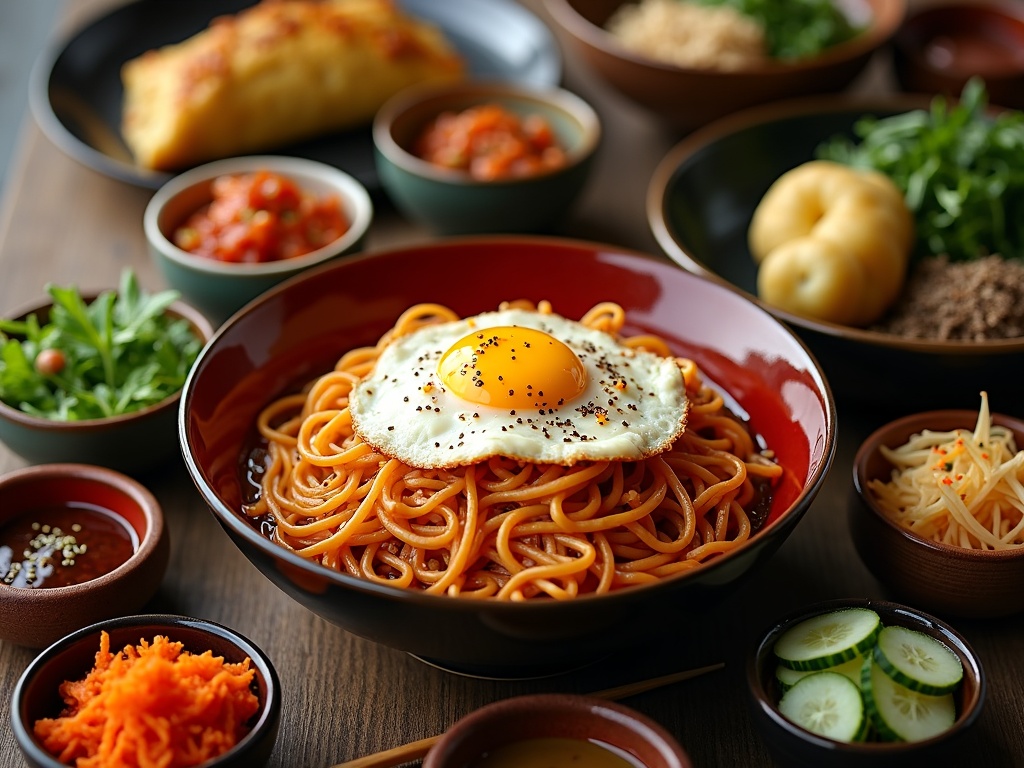
A Global Sensation
Gochujang, the vibrant Korean fermented chili paste, has exploded onto the global culinary scene, transforming from a traditional Korean staple into an international sensation. The market for this spicy-sweet condiment reached an impressive USD 237 million in 2020, with projections showing a steady 6% annual growth in the coming years. I’ve watched this trend evolve from specialty Asian markets to mainstream grocery store shelves across America and Europe.
The popularity of gochujang buttered noodles perfectly captures this phenomenon – it’s a dish that blends Korean flavors with Western pasta techniques, creating something both familiar and excitingly new. This brilliant red paste adds depth, umami, and a pleasant heat that elevates simple buttered noodles into something extraordinary.
Cultural Roots and Modern Fusion
Gochujang holds deep cultural significance in Korean cuisine. For generations, Korean families have prepared this fermented chili paste using traditional methods, often as a communal activity that strengthens family bonds. The paste typically ferments in earthenware pots called onggi, developing complex flavors over months.
Today’s fusion cuisine movement has embraced gochujang’s unique profile, incorporating it into dishes far beyond its traditional applications. I’ve seen creative chefs use it in:
- Pasta dishes like creamy pasta with gochujang butter sauce
- Reimagined classics such as chicken carbonara with a gochujang twist
- Simple dishes like spaghetti aglio e olio elevated with a spoonful of gochujang
- Fusion creations combining gochujang with avocado pasta for spicy-creamy perfection
The beauty of gochujang buttered noodles lies in their adaptability. The dish works brilliantly with Italian pasta styles like spaghetti or Asian noodle varieties such as udon or soba. Some creative home cooks even pair it with chorizo pasta for a Korean-Spanish fusion that showcases the versatility of this ingredient.
What’s fascinating about the gochujang trend is how it’s changed Western perceptions of Korean food. No longer considered exotic or intimidating, Korean flavors have become mainstream. The paste’s balance of heat, sweetness, and umami makes it accessible even to palates unaccustomed to spicy foods.
The growth in market value reflects this shift in consumer preferences toward bolder, more global flavors. Food retailers have responded by stocking multiple brands and varieties of gochujang, from traditional versions to modern interpretations formulated specifically for Western kitchens.
As fusion cuisine continues to break down culinary barriers, gochujang buttered noodles stand as a delicious example of how traditional ingredients can find new life in contemporary cooking. The dish honors its Korean roots while embracing innovation – a perfect representation of modern global cuisine that respects tradition while welcoming change.
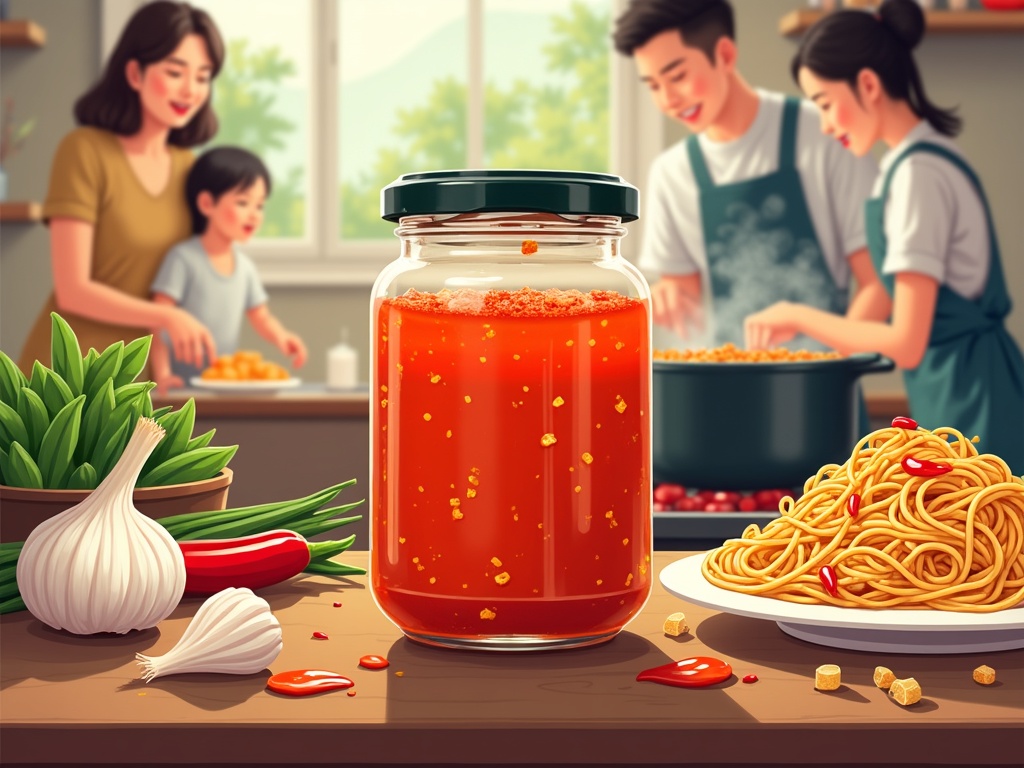
Sources:
National Institutes of Health, Statista, Korean Food Foundation, Various cookbooks and culinary websites on Korean cooking and recipes

